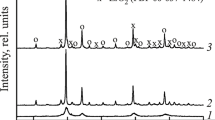Abstract
Material changes in yttrium-doped barium zirconate, BaZr0.8Y0.2O3–x, were studied using in situ Raman spectroscopy and ex situ x-ray photoelectron spectroscopy analysis. During in situ Raman analysis, samples were heated to temperatures of 300–600 °C and exposed to both dry and humidified H2 atmospheres. At the lower temperatures (300–450 °C), a new vibrational peak appears in the Raman spectra during exposure to humidified H2. The appearance of this feature is reversible, dependent on previous sample history, and possibly results from new, secondary phase formation or lattice distortion.




Similar content being viewed by others
References
E. Fabbri, L. Bi, D. Pergolesi, and E. Traversa: Towards the next generation of solid oxide fuel cells operating below 600°C with chemically stable proton-conducting electrolytes. Adv. Mater. 24, 195–208 (2012).
C. Duan, R.J. Kee, H. Zhu, C. Karakaya, Y. Chen, S. Ricote, A. Jarry, E.J. Crumlin, D. Hook, R. Braun, N.P. Sullivan, and R. O'Hayre: Highly durable, coking and sulfur tolerant, fuel-flexible protonic ceramic fuel cells. Nature 557, 217–222 (2018).
D.S. Yun, J. Kim, S.-J. Kim, J.-H. Lee, J.-N. Kim, H.C. Yoon, J.H. Yu, M. Kwak, H. Yoon, Y. Cho, and C.-Y. Yoo: Structural and electrochemical properties of dense yttria-doped barium zirconate prepared by solid-state reactive sintering. Energies 11, 3083 (2018).
B. He, D. Ding, Y. Ling, L. Zhao, and J. Cheng: Fabrication and evaluation of stable micro tubular solid oxide fuel cells with BZCY-BZY Bi-layer proton conducting electrolytes. Int. J. Hydrog. Energy 39, 19087–19092 (2014).
K. Bae, D.Y. Jang, H.J. Choi, D. Kim, J. Hong, B.-K. Kim, J.-H. Lee, J.-W. Son, and J.H. Shim: Demonstrating the potential of yttrium-doped barium zirconate electrolyte for high-performance fuel cells. Nat. Commun. 8, 1–9 (2017).
R. Wang, G. Lau, D. Ding, T. Zhu, and M.C. Tucker: Approaches for co-sintering metal-supported proton-conducting solid oxide cells with Ba(Zr,Ce,Y,Yb)O3-δ electrolyte. Int. J. Hydrog. Energy. 44, 13768–13776 (2019).
F. Lefebvre-Joud, G. Gauthier, and J. Mougin: Current status of proton-conducting solid oxide fuel cells development. J. Appl. Electrochem. 39, 535–543 (2009).
C. Duan, J. Tong, M. Shang, S. Nikodemski, M. Sanders, S. Ricote, A. Almansoori, and R. O'Hayre: Readily processed protonic ceramic fuel cells with high performance at low temperatures. Science 349, 1321–1326 (2015).
R.R. Chien, C.-S. Tu, V.H. Schmidt, S.-C. Lee, and C.-C. Huang: Synthesis and characterization of proton-conducting Ba(Zr0.8−xCexY0.2)O2.9 ceramics. Solid State Ion. 181, 1251–1257 (2010).
A. Dubois, S. Ricote, and R.J. Braun: Comparing the expected stack cost of next generation intermediate temperature protonic ceramic fuel cells with solid oxide fuel cell technology. ECS Trans. 78, 1963–1972 (2017).
N.S. Patki, J.D. Way, and S. Ricote: High performance fuel electrodes fabricated by electroless plating of copper on BaZr0.8Ce0.1Y0.1O3-δ proton-conducting ceramic. J. Power Sources 365, 399–407 (2017).
A. Slodczyk, O. Zaafrani, M.D. Sharp, J.A. Kilner, B. Dabrowski, O. Lacroix, and P. Colomban: Testing the chemical/structural stability of proton conducting perovskite ceramic membranes by in situ/ex situ autoclave raman microscopy. Membranes 3, 311–330 (2013).
F. Giannici, M. Shirpour, A. Longo, A. Martorana, R. Merkle, and J. Maier: Long-range and short-range structure of proton-conducting Y:BaZrO3. Chem. Mater. 23, 2994–3002 (2011).
D. Medvedev, J. Lyagaeva, S. Plaksin, A. Demin, and P. Tsiakaras: Sulfur and carbon tolerance of BaCeO3–BaZrO3 proton-conducting materials. J. Power Sources 273, 716–723 (2015).
C.-Y. Yoo, D.S. Yun, J.H. Joo, and J.H. Yu: The effects of no addition on the structure and transport properties of proton conducting BaZr0.8Y0.2O3−δ. J. Alloys Compd. 621, 263–267 (2015).
M. Kubicek, Z. Cai, W. Ma, B. Yildiz, H. Hutter, and J. Fleig: Tensile lattice strain accelerates oxygen surface exchange and diffusion in La1–xSrxCoO3−δ thin films. ACS Nano 7, 3276–3286 (2013).
M. Riva, M. Kubicek, X. Hao, G. Franceschi, S. Gerhold, M. Schmid, H. Hutter, J. Fleig, C. Franchini, B. Yildiz, and U. Diebold: Influence of surface atomic structure demonstrated on oxygen incorporation mechanism at a model perovskite oxide. Nat. Commun. 9, 1–9 (2018).
M.B. Pomfret, C. Stoltz, B. Varughese, and R.A. Walker: Structural and compositional characterization of yttria-stabilized zirconia: evidence of surface-stabilized, low-valence metal species. Anal. Chem. 77, 1791–1795 (2005).
T. Götsch, E. Bertel, A. Menzel, M. Stöger-Pollach, and S. Penner: Spectroscopic investigation of the electronic structure of yttria-stabilized zirconia. Phys. Rev. Mater. 2, 035801–035809 (2018).
C.-S. Tu, R.R. Chien, V.H. Schmidt, S.C. Lee, and C.-C. Huang: Temperature-dependent structures of proton-conducting Ba(Zr0.8–xCexY0.2)O2.9 ceramics by Raman scattering and X-ray diffraction. J. Phys. Condens. Matter 24, 155403–155410 (2012).
K.S. Blinn: Investigation of electrode surfaces in solid oxide fuel cells using Raman mapping and enhanced spectroscopy techniques. Ph.D. Dissertation, Georgia Institute of Technology, 2012.
X. Li, K. Blinn, D. Chen, and M. Liu: In situ and surface-enhanced Raman spectroscopy study of electrode materials in solid oxide fuel cells. Electrochem. Energy Rev. 1, 433–459 (2018).
R.L. McCreery: Raman Spectroscopy for Chemical Analysis. (John Wiley & Sons, New York, 2000).
A. Slodczyk, P. Colomban, S. Willemin, O. Lacroix, and B. Sala: Indirect Raman identification of the proton insertion in the high-temperature [Ba/Sr][Zr/Ti]O3-modified perovskite protonic conductors. J. Raman Spectrosc. 40, 513–521 (2009).
A. Slodczyk, P. Colomban, D. Lamago, M.-H. Limage, F. Romain, S. Willemin, and B. Sala: Phase transitions in the H+-conducting perovskite ceramics by the quasi-elastic neutron and high-pressure Raman scattering. Ionics 14, 215–222 (2008).
A.A. Sirenko, I.A. Akimov, J.R. Fox, A.M. Clark, H.-C. Li, W. Si, and X.X. Xi: Observation of the first-order Raman scattering in SrTiO3 Thin Films. Phys. Rev. Lett. 82, 4500–4503 (1999).
NIST X-ray Photoelectron Spectroscopy (XPS): Database Main Search Menu. https://srdata.nist.gov/xps/main_search_menu.aspx (accessed April 2, 2020).
CRC: CRC Handbook of Chemistry and Physics. 72nd Edition (CRC Press, Ann Arbor, MI, 1991), pp. 5.16–5.59.
Acknowledgments
The authors gratefully acknowledge support from the National Science Foundation (CHE-1710695). R.A.W. acknowledges additional instrumentation support from the Office of Naval Research (N00014-17-2808).
Author information
Authors and Affiliations
Corresponding author
Supplementary material
Supplementary material
The supplementary material for this article can be found at https://doi.org/10.1557/mrc.2018.38
Rights and permissions
About this article
Cite this article
Welander, M.M., Goettlich, D.J., Henning, T.J. et al. Yttria-stabilized barium zirconate surface reactivity at elevated temperatures. MRS Communications 10, 455–460 (2020). https://doi.org/10.1557/mrc.2020.43
Received:
Accepted:
Published:
Issue Date:
DOI: https://doi.org/10.1557/mrc.2020.43




